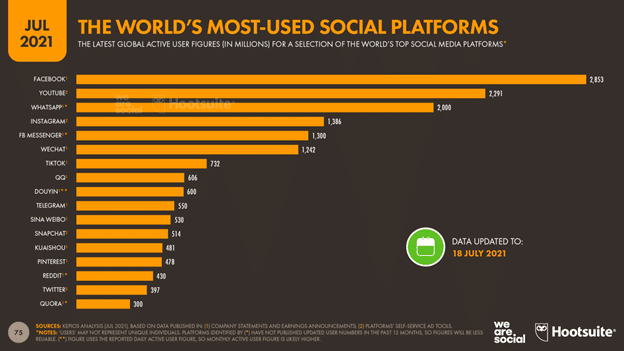Love it or hate it, social media has become a fixture for nearly 4.5 billion users around the world, according to statistics published by Datareportal in July 2021, equivalent to nearly 57% of the world’s population. A typical user actively uses or visits an average of 6.6 different social media platforms each month and spends an average of close to 2.5 hours using social media each day, which means that people spend about 15% of their waking lives using social media.
Companies of all types cannot afford to ignore social media. Rather, they can and should use these platforms to reach out and engage with customers, and, perhaps most importantly, should use these channels to collect deeper feedback about their brand, service, and products. While certain social media sites clearly lead the market, in terms of active users, it is important to understand which channels and platforms are used by each target customer persona. Clearly, the 800-pound gorillas are Facebook and YouTube, but others still generate millions of active users. Another key element to consider is the type of content customers respond to and engage with, as some user personas are more likely to actively create or respond to content than others (e.g., older users like Baby Boomers may view a video on social media, but may not create them).

Once the organization’s customer personas are understood, there are several ways to collect customer feedback via social media channels:
- Actively monitor and listen: In order to gain insights about customers, it is important to actively monitor and listen to what is being said about the brand, product, or service. Hashtags can be useful for quicky seeing what customers or prospects say, and identifying specific brand, product, or service perceptions. Because social media posts can quickly go viral, it is likely that specific trends or insights will become apparent quickly, particularly if influencers are involved. Perhaps most notably, people are more honest when they are not directly interacting with an official company representative, so using social media to capture real-world perceptions can generate significant value beyond traditional surveys.
- Create and deploy polls and surveys through social channels: Deploying polls or surveys via social media can still generate value, largely because they immediately reach customers or prospects, and facilitate customer engagement. Further, launching these polls or surveys demonstrates that the company is truly interested in the opinions of its stakeholders.
- Focus on providing information, not just offers: Your online presence directly contributes to brand building and increasing awareness. Be cautious to not go overboard with marketing and instead create a beneficial balance of information and offers. Aim to provide value with every post you share, ask questions, give answers, and develop a brand personality that resonates to build a strong reputation.
- Quickly engage and respond: Customers expect the companies with which they interact to be available 24/7, and immediately responsive to their inquiries via social media. This can be achieved by deploying intelligent bots to handle simple inquiries and to acknowledge their message, as well as by employing a social media staff to handle more complex issues. This can reduce call center costs, increase retention, and enhance CX.
With all these tactics, the key is to analyze these interactions to find patterns of behavior, which can be used to improve marketing, sales, or CX efforts. These patterns can be found in the way customers respond to specific outreach via social media (e.g., the content of posts, their timing, and platform), as well as what types of outreach generate the most benefits to the customers. An often overlooked approach is to analyze the actions taken by the customer after the company has engaged with them. For example, companies should analyze whether a conversation between the company and a customer on a social media channel extends beyond one or two interactions, or if it migrates to another channel, such as a phone call or an email. By analyzing the content, type, format, channel, and impact of social media interactions, companies can further refine customer personas, and reduce the friction inherent in the customer-company relationship. By reducing friction, customers are likely to perceive a “better” CX, which can lead to a more loyal customer, generating repeat business.
Author Information
Keith Kirkpatrick is Research Director, Enterprise Software & Digital Workflows for The Futurum Group. Keith has over 25 years of experience in research, marketing, and consulting-based fields.
He has authored in-depth reports and market forecast studies covering artificial intelligence, biometrics, data analytics, robotics, high performance computing, and quantum computing, with a specific focus on the use of these technologies within large enterprise organizations and SMBs. He has also established strong working relationships with the international technology vendor community and is a frequent speaker at industry conferences and events.
In his career as a financial and technology journalist he has written for national and trade publications, including BusinessWeek, CNBC.com, Investment Dealers’ Digest, The Red Herring, The Communications of the ACM, and Mobile Computing & Communications, among others.
He is a member of the Association of Independent Information Professionals (AIIP).
Keith holds dual Bachelor of Arts degrees in Magazine Journalism and Sociology from Syracuse University.







